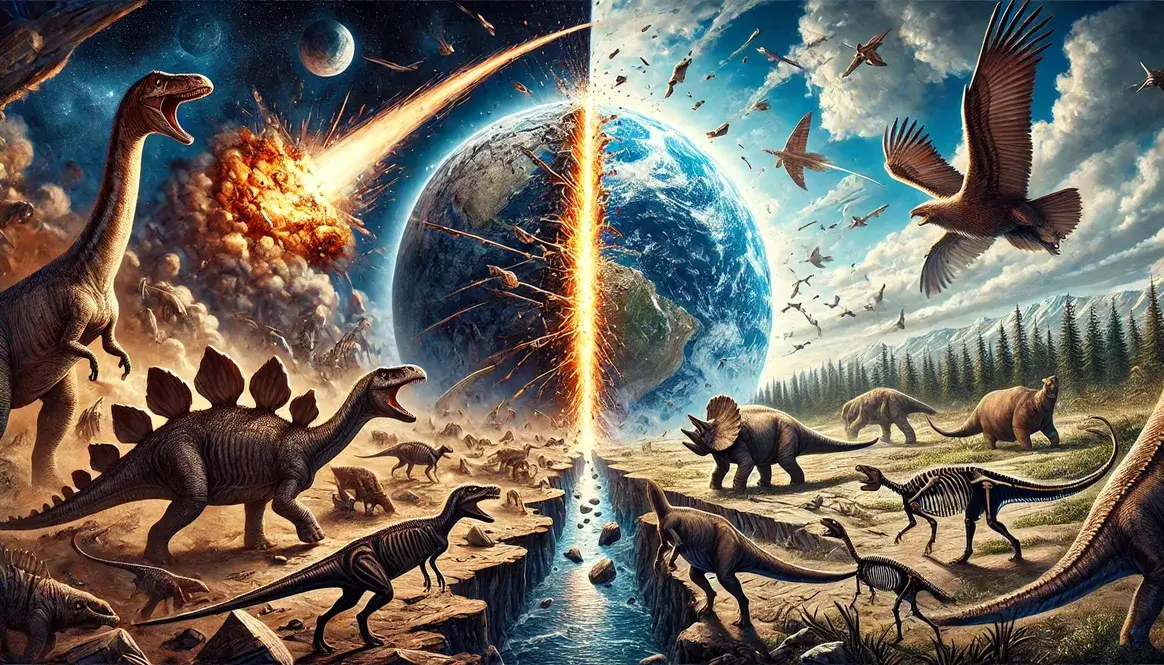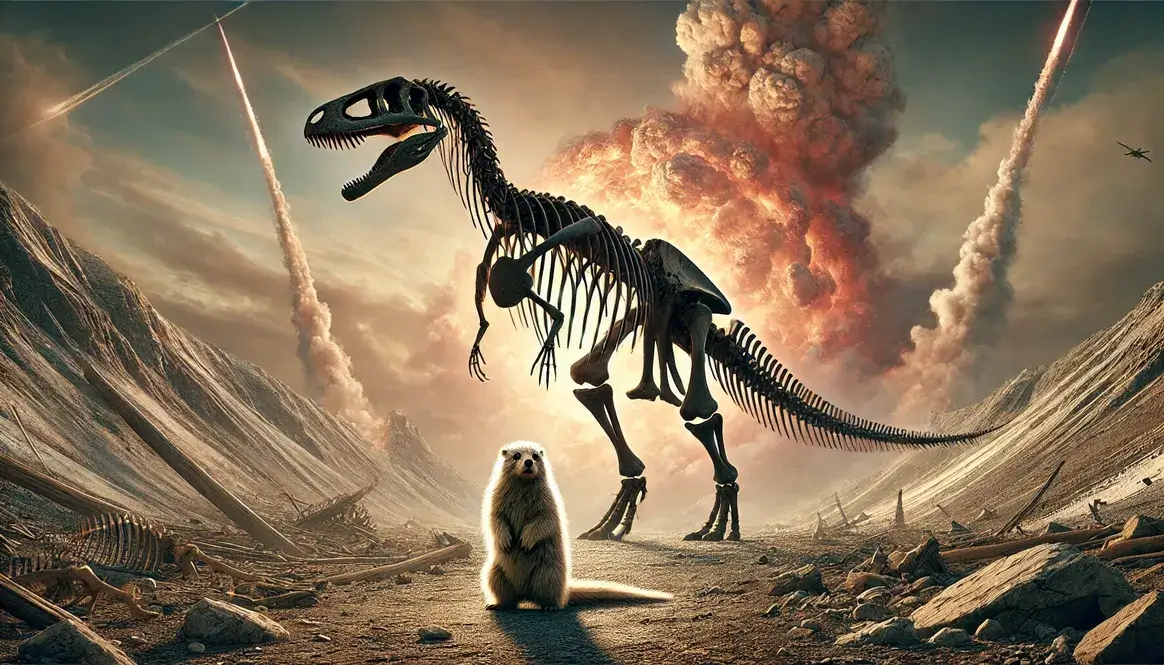The Cretaceous-Paleogene (K-Pg) extinction event, which wiped out the non-avian dinosaurs 66 million years ago, continues to fascinate scientists. Recent discoveries have dramatically changed our understanding of this pivotal moment in Earth’s history. Researchers have uncovered new evidence about the impact’s intensity, refined the timeline of extinction events, and revealed surprising details about global climate changes in the aftermath.
Latest Research on K-Pg Extinction: Key Findings
The most recent studies on the K-Pg extinction have yielded groundbreaking insights. Scientists now have a clearer picture of the asteroid impact’s power, a more precise timeline of the extinction process, and a better understanding of the rapid climate shifts that followed.
New Evidence for Impact Intensity
Recent research has provided startling new details about the asteroid impact that triggered the K-Pg extinction. A 2019 study published in the Proceedings of the National Academy of Sciences used advanced computer simulations to calculate the impact’s energy. The results were staggering:
| Impact Feature | Measurement |
|---|---|
| Asteroid size | 6-9 miles (10-14 km) in diameter |
| Impact energy | Equivalent to 10 billion atomic bombs |
| Crater depth | 12 miles (19 km) deep |
| Crater width | 124 miles (200 km) wide |
These findings highlight the catastrophic nature of the impact, which released an enormous amount of energy in a matter of seconds. The force was so great that it vaporized rock and sent debris high into the atmosphere, blocking out sunlight and triggering a global winter.
Refined Timeline of Extinction Events
New research has also sharpened our understanding of how quickly the extinction unfolded. A 2019 study in Geology examined fossil records from the El Kef section in Tunisia, a key K-Pg boundary site. The researchers found that:
- Marine ecosystems collapsed within days or months of the impact
- Land-based ecosystems took several thousand years to fully collapse
- The entire extinction process lasted less than 30,000 years
This timeline suggests that while the impact had immediate catastrophic effects, some ecosystems were more resilient than others. The gradual collapse of land ecosystems provides new insights into the complex dynamics of mass extinctions.
Updated Global Temperature Changes
Recent studies have revealed surprising details about temperature fluctuations following the K-Pg impact. A 2020 study in Science used advanced climate models and geological evidence to reconstruct temperature changes:
- Initial global cooling: Temperatures dropped by up to 50°F (28°C) within days of the impact
- Short-term warming: A brief period of warming occurred due to the release of carbon dioxide from vaporized rock
- Long-term cooling: Temperatures remained below pre-impact levels for about 30 years
These findings help explain why some cold-adapted species survived the extinction while others perished. The rapid temperature swings would have posed significant challenges for many organisms, contributing to the mass die-off of large animals.
These recent discoveries have significantly advanced our understanding of the K-Pg extinction event. They provide a more detailed and nuanced picture of the impact’s intensity, the timeline of extinction, and the complex climate changes that followed. As research continues, we can expect even more insights into this crucial moment in Earth’s history.
Cutting-Edge Technologies in K-Pg Research
The study of the K-Pg extinction has been revolutionized by cutting-edge technologies. These new tools and methods are helping scientists unlock secrets hidden for millions of years.
Advanced Geochemical Analysis Techniques
Recent advancements in geochemistry have allowed researchers to extract more information from K-Pg boundary rocks than ever before. Some of these techniques include:
- Laser Ablation ICP-MS: This method uses lasers to vaporize tiny portions of rock samples, which are then analyzed by mass spectrometry. It provides highly detailed chemical composition data.
- Isotope Analysis: By studying the ratios of different isotopes in K-Pg boundary rocks, scientists can reconstruct ancient temperatures and carbon cycle changes.
- Organic Geochemistry: Analysis of organic molecules preserved in sediments offers insights into ancient ecosystems and climate conditions.
These techniques have revealed new details about the impact’s global effects, including evidence of widespread wildfires and rapid ocean acidification in the aftermath of the asteroid strike.
High-Resolution Climate Modeling
Computer models have become powerful tools in K-Pg extinction research. Today’s climate models can simulate complex interactions between the atmosphere, oceans, and land surfaces with unprecedented detail.
Recent models have helped scientists understand:
- How dust and aerosols from the impact affected global climate
- The duration and severity of the impact winter
- Regional variations in climate effects
One groundbreaking study used a high-resolution model to simulate the first few years after the impact. It showed that global temperatures could have plummeted by up to 50°F (28°C) within days, with devastating consequences for life on Earth.
| Time After Impact | Global Temperature Change |
|---|---|
| 1 day | -10°F (-5.5°C) |
| 1 week | -25°F (-14°C) |
| 1 month | -40°F (-22°C) |
| 6 months | -50°F (-28°C) |
These models provide crucial context for interpreting fossil evidence and understanding why some species survived while others perished.
Microfossil Examination with Electron Microscopy
Electron microscopy has opened up a new world of discovery in K-Pg extinction research. By examining microfossils at extremely high magnifications, scientists can gather valuable data about ancient environments and the extinction’s impact on microscopic life.
Some key findings from electron microscopy studies include:
- Evidence of impact debris in marine microfossils
- Changes in plankton communities immediately after the impact
- Signs of ocean acidification in the shells of marine microorganisms
One fascinating discovery came from examining the fossilized remains of fish. Using a scanning electron microscope, researchers found impact spherules (tiny glass beads formed from vaporized rock) lodged in the gills of fish fossils from North Dakota. This finding suggests that some fish died within hours of the impact, choking on debris raining down from the sky.
These advanced technologies are pushing the boundaries of what we can learn about the K-Pg extinction. As they continue to evolve, we can expect even more groundbreaking discoveries that will reshape our understanding of this crucial event in Earth’s history.
Current Scientific Debates and Controversies
While the K-Pg extinction event is well-established in scientific literature, several key debates continue to spark lively discussions among researchers. These ongoing controversies highlight the complexity of studying events that occurred millions of years ago and the challenges of interpreting limited fossil evidence.
Single Impact vs. Multiple Impact Hypotheses
The debate over whether the K-Pg extinction was caused by a single large impact or multiple smaller impacts remains active. Most scientists support the single impact theory, centered on the Chicxulub crater in Mexico. However, some researchers argue for a multiple impact scenario:
Single Impact Proponents Say:
- The Chicxulub crater is the right size and age
- Global iridium layer is consistent with a single large impact
- No other craters of similar age and size have been conclusively identified
Multiple Impact Supporters Argue:
- Some geological features suggest multiple impacts
- Multiple impacts could explain patterns in fossil records
- Potential candidates for additional impact sites exist
Recent research has focused on dating potential impact sites more precisely. A 2020 study re-examined the Boltysh crater in Ukraine, previously thought to be a potential second K-Pg impact site. The results showed it formed about 650,000 years after the Chicxulub impact, ruling it out as a contributor to the K-Pg extinction.
Role of Deccan Traps Volcanism
The contribution of massive volcanic eruptions to the K-Pg extinction is another area of ongoing debate. The Deccan Traps in India were active around the time of the extinction, leading some scientists to question whether volcanism played a significant role.
| Volcanism Factors | Potential Effects |
|---|---|
| CO2 emissions | Global warming |
| Sulfur emissions | Short-term cooling |
| Mercury release | Environmental toxicity |
New research has provided intriguing insights:
- Timing: Recent high-precision dating suggests the most intense phase of Deccan volcanism occurred after the impact.
- Climate Effects: Models indicate volcanic CO2 emissions may have helped warm the planet after the impact winter.
- Ecosystem Stress: Some scientists argue that Deccan volcanism weakened ecosystems before the impact, making them more vulnerable.
While most researchers agree that the asteroid impact was the primary cause, the role of Deccan volcanism in shaping the extinction’s severity and recovery patterns remains a topic of active research.
Extinction Patterns Across Different Ecosystems
One of the most intriguing debates in K-Pg extinction research concerns the varying impacts on different ecosystems. Scientists are still working to understand why some environments and species were more affected than others.
Key points of discussion include:
- Marine vs. Terrestrial Extinction Rates: Some studies suggest marine ecosystems were hit harder than land ecosystems, while others argue the opposite.
- Freshwater Resilience: Evidence indicates that freshwater ecosystems were less severely impacted. Researchers debate why this might have been the case.
- Polar Survival: Some polar species appear to have survived better than their tropical counterparts. Scientists are exploring whether this was due to adaptations to darkness or other factors.
- Size-Selective Extinction: While large animals generally fared poorly, there were exceptions. The reasons for these exceptions are hotly debated.
These debates highlight the complexity of the K-Pg extinction event. As new evidence emerges, our understanding of how different ecosystems responded to this catastrophic event continues to evolve.
The ongoing controversies in K-Pg extinction research demonstrate that science is a dynamic process. Each new study and debate brings us closer to a fuller understanding of this pivotal moment in Earth’s history, shedding light on the resilience of life in the face of global catastrophe.
Implications for Understanding Mass Extinctions
Recent research on the K-Pg extinction event has significantly enhanced our understanding of mass extinctions in general. These insights are reshaping how we view Earth’s past and potentially its future.
Refining Extinction Vulnerability Factors
New studies have provided fresh perspectives on why certain species survived the K-Pg extinction while others perished. This research is helping scientists identify key factors that influence extinction vulnerability:
- Body Size: Larger animals generally fared worse, possibly due to higher energy requirements and longer generation times.
- Dietary Flexibility: Generalist feeders had a higher survival rate than specialists.
- Habitat Preferences: Burrowing animals and those living in aquatic environments showed higher survival rates.
- Geographic Location: Species in certain regions, such as the Arctic, appeared to have higher survival rates.
- Reproductive Strategies: Animals with faster reproduction cycles and those that laid eggs seemed to have an advantage.
These findings are crucial for understanding not only past extinctions but also for predicting which species might be most at risk in future environmental crises. For instance, the survival of small mammals during the K-Pg event offers insights into adaptability and resilience in the face of rapid environmental change.
Ecosystem Recovery Patterns
The latest research on ecosystem recovery after the K-Pg extinction has revealed fascinating patterns:
Rapid Initial Recovery: Studies show that life began to rebound surprisingly quickly in some areas. Microbial communities in the oceans started recovering within years, while land plants began re-establishing within centuries.
Delayed Diversity: While basic ecosystem functions recovered relatively quickly, it took millions of years for biodiversity to reach pre-extinction levels. This pattern of rapid functional recovery followed by slow diversification seems to be common in mass extinctions.
Evolutionary Opportunities: The extinction created new ecological niches, leading to rapid evolution and diversification of surviving groups. Mammals, for example, experienced an explosion of diversity in the aftermath of the extinction.
| Time After Extinction | Recovery Milestone |
|---|---|
| Years to decades | Microbial recovery |
| Centuries | Initial plant recovery |
| Thousands of years | Reestablishment of complex food webs |
| Millions of years | Return to pre-extinction biodiversity levels |
These insights are crucial for understanding how ecosystems might recover from current and future environmental challenges.
Applying K-Pg Insights to Other Extinction Events
The detailed study of the K-Pg extinction has provided a valuable framework for understanding other mass extinctions in Earth’s history. Some key applications include:
- Extinction Mechanisms: The multi-faceted nature of the K-Pg extinction (impact, climate change, possibly volcanism) has led scientists to look for similar combinations of factors in other extinction events.
- Recovery Patterns: The observed patterns of ecosystem recovery after the K-Pg event are being used to interpret the fossil record of other extinctions, helping to fill gaps in our understanding.
- Climate Change Impacts: The rapid climate shifts associated with the K-Pg event provide insights into how abrupt climate change can affect global ecosystems, informing studies of climate-driven extinctions like the end-Permian event.
These applications are not just academic exercises. By understanding the mechanisms and consequences of past mass extinctions, scientists can better predict and potentially mitigate the impacts of the ongoing biodiversity crisis.
The study of the K-Pg extinction continues to yield valuable insights into the nature of mass extinctions and the resilience of life on Earth. As we face current environmental challenges, these lessons from the past become increasingly relevant, offering both warnings and hope for the future of our planet’s ecosystems.









